Cows were brought into Argentina by the Spanish in 1536. The cattle soon multiplied as a result of the geography of the Pampas and a local market. The introduction of refrigerated trains and ships in the late nineteenth century paved the way for strong exports to the United States and Europe. The flipped seasons between the Northern and Southern Hemispheres meant that Argentine beef came onto the market at a time of year when beef was less at hand in the Northern Hemisphere, thus elevating the product.
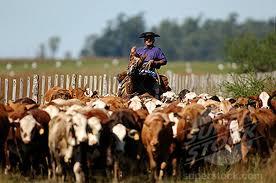
Gaucho and cows
Argentine beef and its production have played a major part in the culture of Argentina, from the asado to the history of the gauchos of the Pampas. Landowners became wealthy from beef production and export, and estancia owners built large houses, important buildings in Buenos Aires and elsewhere, and contributed to politics, philanthropy and society.
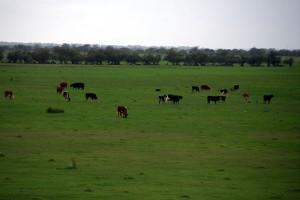
Argentine Pampas
So there was clearly money to be made from cows in Argentina but why are they so popular and what makes them delicious?
Beef quality is dependent on the diet provided to cattle and their living conditions. The two different farming regimes used for beef production in Argentina are grass pasture and feedlot-based farming. Argentina’s rainfall and largely temperate climate result in high quality pastures, which may, however, not be suitable for more intensive agriculture. The Humid Pampa (Pampa Húmeda) is an extensive region of flat, fertile grassland of loessic origin in central to lower Argentina. It has a precipitation average of 900 mm per year and is the most important and best-known cattle-producing region, as it has vast and open pastures. Grass-fed beef is believed to be healthier than beef from feedlots, as it contains more omega three fatty acids than grain-fed beef, and so does not contribute so much to raising cholesterol in humans. Although the latter diet is increasing, grass-fed beef is still the most popular in Argentina
Grass-fed cattle are living under more natural conditions, and are less likely to have hormone implants. On the other hand, the technique requires large amounts of expensive land and a larger number of trained staff. Additionally, it takes longer to raise the animal.
As beef is increasingly mass-produced, farming techniques with the ultimate goal of fattening the animals are evolving; the most common of these is grain-fed beef cattle held in feedlots. But as the animals, denied physical effort and stocked together, get fatter. In order to prevent disease on farms and feedlots, the animals are fed antibiotics. The feedlot diet guarantees constant and controlled results, year-round productivity as it is not as dependent on climate and does not require so much land. Taking into consideration all these factors, it is thus the cheaper diet, but there are suggestions it is less beneficial for the welfare of the animals and for the health-giving qualities and flavor of the meat.
It may prove difficult for the consumers in Argentina, either buying in a restaurant or at a butchers shop, to identify whether the cow has been grass fed or grained fed. Labeling has yet to really take off in Argentina. However if you ask your local butcher nicely than then he might provide you with the answer. You can ask this in restaurants as well. If they do not know whether the cow has been grass fed or grain fed then its likely that it has been grain fed. Ultimately you will know after your meal. Once you have found your trusted beef supplier then stick to it and develop a good relationship.
Two breeds of cows worth looking for:
Horthorn
Originally from northeast England, the shorthorn was introduced to Argentina in 1826 and was the first foreign breed to enter the country. As in many other countries, Argentina’s selection was designated to produce not only meat but milk as well.
Aberdeen Angus
Originally from Scotland, the Aberdeen angus were first introduced to Argentina by Don Carlos Guerrero in 1879. They are generally found in temperate climates. Instead of focusing on crossbreeding in order to strength their qualities, Argentine farmers decided to focus on a purebred evolution based on natural and high-quality nutrition.
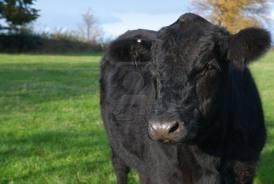
Aberdeen Angus
Here are the main cuts to go for; In Spanish and English;
1. bife de chorizo – sirloin; a thick, juicy and popular cut
2. bife de costilla – T-bone; a cut close to the bone; also called chuleta
3. bife de lomo – tenderloin; a thinly cut, more tender piece
4. cuadril – rump steak; often a thin cut
5. ojo de bife – ribeye; a choice smaller morsel
6. tira de asado – shortribs; thin strips of ribs and meat sliced crosswise
7. vacío – flank steak; textured and chewy, but very tasty
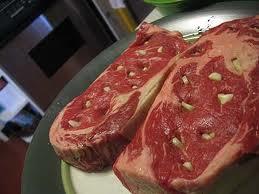
Nicely prepared
If you don’t specify, your steak will be cooked a punto (medium). To get it pink on the inside ask for jugoso (medium rare). Vuelta y vuelta or poco cocido means rare, and well done is bien cocido.
Asado is a term used both for a range of barbeque techniques and the social event of having or attending a barbecue. A great way to enjoy yourself whilst learning the Spanish language.
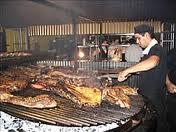
Parrilla
You will find numerous parrillas in Buenos Aires. These are essentially steakhouses. The parrilla is the actual bbq itself. Ensure that the parrilla is authenic, uses natural coals and is operated by a competent individual.
.
